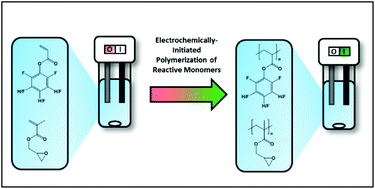Electrochemically-initiated polymerization of reactive monomers via 4-fluorobenzenediazonium salts†
Abstract
The straightforward electrochemically-initiated radical polymerization of three reactive monomers, i.e. 2,6-difluorophenyl acrylate (DFPA), pentafluorophenyl acrylate (PFPA), and glycidyl methacrylate (GMA), using a simple commercially available electrochemical setup for the generation of initiating radical species from 4-fluorobenzenediazonium tetrafluoroborate upon electrochemical cathodic reduction is reported. The use of a fluorine-labelled initiator allowed for the determination of number-average molar masses Mn of fluorine-containing polymers by 19F NMR spectroscopy in addition to size-exclusion chromatography. The obtained polymers were thereafter successfully subjected to post-polymerization modifications in order to emphasize the applicability of this polymerization method in regard to highly reactive monomers.



 Please wait while we load your content...
Please wait while we load your content...